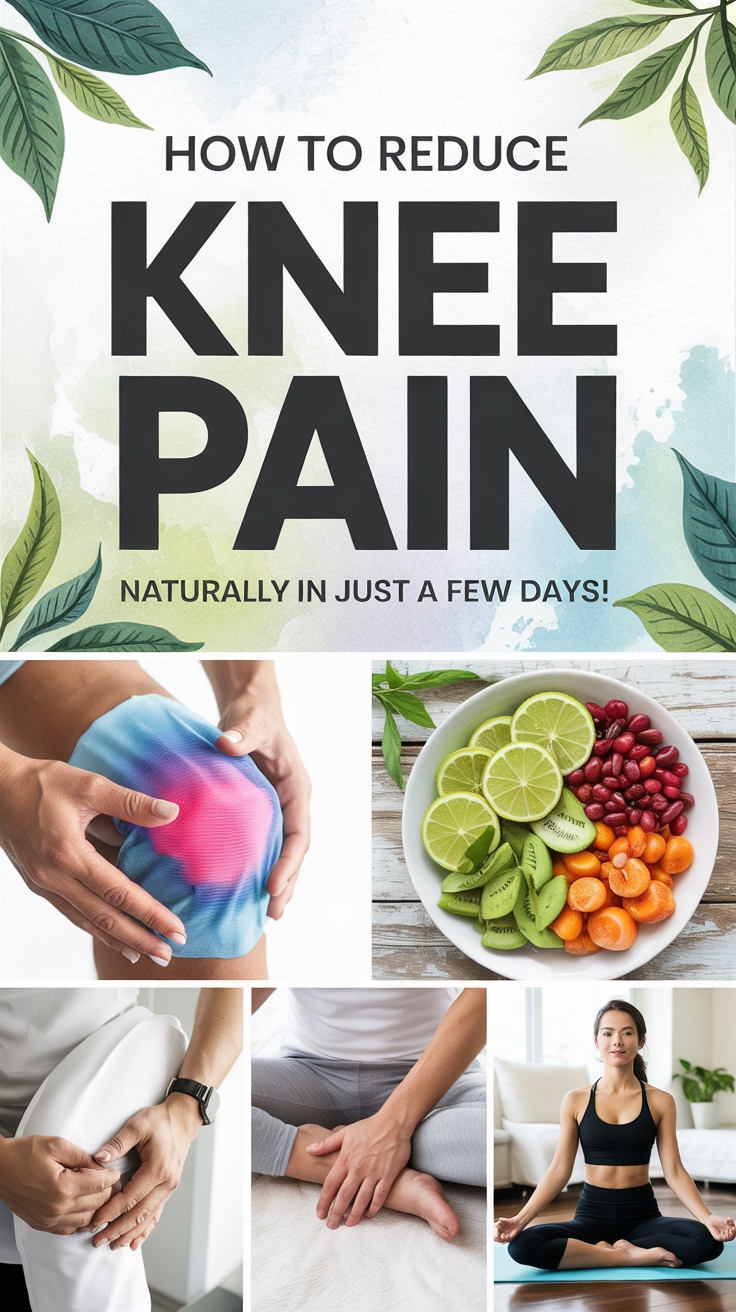How to Reduce Knee Pain Naturally in Just a Few Days!
If you’re struggling with knee pain, you’re not alone. Many people seek natural ways to alleviate discomfort quickly. By making simple changes to your diet, incorporating specific exercises, and employing mindful techniques, you could find relief in just a few days. Curious about how these methods work together? Let’s explore effective strategies that can support your journey to a pain-free life.
Understanding the Causes of Knee Pain
When you experience knee pain, it’s crucial to understand the underlying causes to address it effectively.
Knee pain can arise from various issues, including injuries, overuse, or conditions like arthritis. By identifying these causes, you can explore targeted knee pain relief remedies that suit your needs. Common symptoms include swelling and difficulty bending, which can help in determining the appropriate treatment. Additionally, the use of curcumin in turmeric has been shown to provide effective pain relief, similar to traditional medications.
For instance, stretching and strengthening exercises might help improve flexibility and support your joints. Additionally, applying ice or heat can offer immediate comfort. Understanding the role of inflammation is key to managing your pain effectively.
Connecting with others who share similar struggles can also provide encouragement and insight. Remember, you’re not alone in this journey; together, you can find solutions that work for you.
The Role of Nutrition in Joint Health
Nutrition plays a significant role in maintaining joint health, particularly when you’re dealing with knee pain. By fueling your body with nutrient-rich foods, you can support cartilage and reduce inflammation. Incorporating natural compounds found in foods, such as turmeric and ginger, can also aid in reducing swelling.
Incorporate omega-3 fatty acids found in fish, walnuts, and flaxseeds, as they help ease swelling. Antioxidant-packed fruits and vegetables, like berries and leafy greens, combat oxidative stress.
Don’t forget about vitamins C and D, crucial for collagen production and bone strength. Staying hydrated is vital, too, as it lubricates your joints. Additionally, focusing on anti-inflammatory foods can significantly enhance your recovery process.
Embrace these dietary changes, and you’ll feel more empowered on your journey to healthier knees and a vibrant life.
Essential Stretching and Strengthening Exercises
While you might think rest is the best remedy for knee pain, incorporating essential stretching and strengthening exercises can actually provide significant relief and improve your overall joint function.
Start with gentle stretches like hamstring and quadriceps stretches to enhance flexibility. Strengthening exercises, such as leg raises and wall sits, build the muscles around your knee, offering better support.
Aim for consistency, dedicating just a few minutes daily. You’re not alone in this journey—many others find joy in moving together, encouraging each other to stay active and engaged.
Embrace these exercises, and you’ll feel more connected to your body and community.
The Benefits of Hot and Cold Therapy
Hot and cold therapy can be game-changers for managing knee pain, as each method offers unique benefits that promote healing and comfort.
Applying heat relaxes your muscles, increases blood flow, and eases stiffness, making it perfect for chronic pain. On the other hand, cold therapy numbs the area, reduces swelling, and can help after activity or injury.
Switching between these therapies can create a sense of balance and relief, making you feel more connected to your body’s healing process. Additionally, incorporating regular movement into your routine stimulates synovial fluid production, lubricating joints and enhancing the effectiveness of these therapies.
Incorporating hot and cold treatments into your routine fosters a supportive environment for recovery, allowing you to engage fully in life again.
Herbal Remedies for Pain Relief
After exploring hot and cold therapy, it’s time to consider another natural approach to managing knee pain: herbal remedies.
You might find relief with turmeric, known for its anti-inflammatory properties, or ginger, which can soothe discomfort.
Try applying arnica gel directly on your knee for localized relief. Additionally, willow bark has a history of use for pain management, similar to aspirin.
Don’t forget about the calming effects of chamomile tea; it can help reduce tension and promote relaxation. Certain herbs and botanicals contain compounds that mimic the body’s pain-relieving substances, enhancing the effectiveness of these remedies.
Joining a community focused on natural healing can also provide support and shared experiences to enhance your journey toward pain relief.
Incorporating Anti-Inflammatory Foods
Incorporating anti-inflammatory foods into your diet can significantly help alleviate knee pain and improve overall joint health.
By making these simple changes, you’ll feel more energized and connected to your body. Here are three foods to consider:
-
Fatty Fish: Rich in omega-3 fatty acids, they reduce inflammation and support joint function. Additionally, natural solutions provide alternatives to traditional pain relief methods.
-
Berries: Packed with antioxidants, they combat oxidative stress and may lower pain levels.
-
Leafy Greens: Full of vitamins and minerals, they promote overall health and reduce inflammation.
Additionally, staying well-hydrated is essential for reducing inflammation and preventing kidney stone formation. Embracing these foods not only nourishes your body but also fosters a sense of community around healthy living.
The Importance of Maintaining a Healthy Weight
Maintaining a healthy weight plays a significant role in managing knee pain and overall joint health.
When you carry extra pounds, your knees endure more stress with every step you take. By shedding those pounds, you reduce the strain on your joints, which can lead to significant pain relief.
Plus, being part of a community focused on wellness can make the journey easier and more enjoyable. Surround yourself with supportive friends or groups who share similar goals.
Remember, every small change counts, and together, you can achieve a healthier weight and happier, pain-free knees.
Let’s embrace this journey together!
Exploring Natural Supplements for Joint Support
When you’re looking for ways to alleviate knee pain, exploring natural supplements can be a beneficial approach.
These options not only support joint health but also foster a sense of community among those who share similar struggles.
Consider these three supplements:
-
Glucosamine: This compound can help reduce pain and improve joint function.
-
Turmeric: Known for its anti-inflammatory properties, it may ease discomfort effectively.
-
Omega-3 Fatty Acids: Found in fish oil, they can reduce stiffness and improve mobility.
Integrating these supplements into your routine could connect you with others seeking relief and support.
The Impact of Proper Footwear on Knee Pain
While natural supplements play a significant role in supporting joint health, the importance of proper footwear shouldn’t be overlooked in your journey to reduce knee pain.
Wearing shoes that provide adequate support and cushioning can significantly alleviate pressure on your knees. Look for footwear with a sturdy sole and arch support, as this helps distribute your weight evenly.
Avoid high heels or worn-out shoes that lack support. Taking the time to choose the right footwear not only enhances your comfort but also fosters a sense of community among those who prioritize their well-being.
Your knees will thank you for it!
Mindfulness and Relaxation Techniques for Pain Management
How can mindfulness and relaxation techniques help you manage knee pain? By focusing your mind and calming your body, you can reduce stress and enhance your overall well-being.
Here are three techniques to consider:
-
Deep Breathing: Take a few moments each day to focus on your breath. Inhale deeply through your nose, hold, and exhale slowly. This can help lower tension and pain.
-
Meditation: Spend time in quiet reflection. It helps you connect with your body and distracts from discomfort.
-
Gentle Yoga: Incorporate simple stretches to improve flexibility and relieve pain, fostering a stronger connection to your body.

